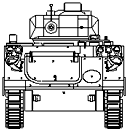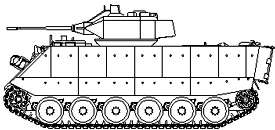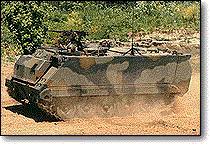 The M113A1, informally known as the Gavin, is a lightly armoured full tracked air transportable personnel carrier designed to carry personnel and certain types of cargo. The M113-family was developed from M59 and M75 by Ford and Kaiser Aluminium and Chemical Co. in the late 1950īs. The vehicle is capable of: amphibious operations in streams and lakes; extended cross country travel over rough terrain; and high speed operation on improved roads and highways.
The M113A1, informally known as the Gavin, is a lightly armoured full tracked air transportable personnel carrier designed to carry personnel and certain types of cargo. The M113-family was developed from M59 and M75 by Ford and Kaiser Aluminium and Chemical Co. in the late 1950īs. The vehicle is capable of: amphibious operations in streams and lakes; extended cross country travel over rough terrain; and high speed operation on improved roads and highways.
The M113 Family includes approximately 12 variants of light armored tracked vehicles used in a variety of combat and combat support roles. Total density exceeds 28,000. Today's M113 Family of Vehicles is composed of a mix of derivative systems consisting of the A1, A2, and A3 configurations. The current fleet includes: M113A2; M113A3; M106A2; M1064; M1064A3; M548A1; M548A3; M577A2; M577A3; M730A2; M901A1; M981; M1068; M1068A3; M1059; and M1059A3. Over the next 10-15 years, the majority of these systems will be converted to the A3 configuration.
- M58 Wolf Smoke Generator Carrier
- M106 Self-propelled 107mm Mortar
- M113 Armored Medical Evacuation Vehicle AMEV
- M125 Self-propelled 81mm Mortar
- M548 Cargo Carrier
- M577 Command Post Carrier
- M730 Guided Missile Equipment Carrier (Chaparral)
- M901 Improved TOW Vehicle
- M981 Fire Support Team Vehicle (FISTV)
- M1059 Lynx Smoke Generator Carrier
- M1064 Self-propelled 120mm Mortar
- M1068 Standard Integrated Command Post System (SICPS) Carrier
- M1108 Universal Carrier
Since their initial introduction in 1960, M113-based systems
have entered service in more than 50 countries. The systems have been modified
into more than 40 identified specific variants, with many times that number
of minor field modifications. Many of these modifications have been developed
by foreign governments to meet their specific national requirements. While
some older M113 derivatives are being retired and removed from selected
inventories, other FOV members are being upgraded, reconfigured, and introduced
as entirely new systems.
More than 80,000 M113 Family of Vehicle (FOV) systems have
been produced. New M113 FOV systems
are being built while existing chassis are being upgraded to modern configurations.
The M113 APC was the first modern "battle taxi"; developed to transport
infantry forces on the mechanized battlefield. It is fitted with a 2 stroke six cylinder Detroit diesel providing power through a 3 speed automatic gearbox and steering differential. The main armament is a single .50 Cal heavy barrel machine gun, and the secondary armament is a single .30 Cal machine gun. The M113 is built of aircraft quality aluminum which allows it to possess some of the same strengths as steel at a much lighter weight. This distinct weight advantage allows the M113 to utilize a relatively small engine to power the vehicle, as well as carry a large payload cross-country. The vehicle is capable of "swimming" bodies of water.
The vehicle is not mission capable if any one track shoe is damaged. If the M113 loses a track, breaks a track shoe or the vehicle throws a track, extreme caution must be exercised in maintaining control. The driver must immediately release the accelerator and let the vehicle coast to a stop. Applying braking action, i.e. brake pedal, laterals, pivot or any type of steering controls causes the vehicle to pull to the active or good track and could result in a roll-over. If it is absolutely necessary, the driver may apply braking action only, and only if the vehicle is approaching a ravine, a cliff, or if other catastrophic outcome, probably resulting in fatalities. When roll-over is imminent; it is safer to stay in the vehicle than to try to get out while the vehicle is still moving. Crew members may receive slight injuries from being thrown against metal parts, but if they try to leave the vehicle, it may roll over and crush them. Once the vehicle stops moving, the crew should get out as fast as possible because spilled fuel and oil may catch on fire. The first thing the driver should do in such an emergency is shut off the engine and turn off the master switch to minimize the fire hazard.
M113 Armored Personnel Carrier
The original M113 Armored Personnel Carrier (APC) helped
to revolutionize mobile military operations. The vehicles were able to carry
11 soldiers plus a driver and track commander under armor protection across
hostile battlefield environments. More importantly, the new vehicles were
air transportable, air-droppable, and swimmable, allowing planners to incorporate
APCs in a much wider range of combat situations, including many "rapid
deployment" scenarios. The M113s were so successful that they were
quickly identified as the foundation for a family of vehicles. Early derivatives
included both command post (M577) and mortar carrier (M106) configurations.
M113A1 Armored Personnel Carrier
The first major upgrade came in 1964 with the introduction
of the M113A1 package which replaced the original gasoline engine with a
212 horsepower diesel package. The new power train was soon incorporated
into the existing vehicle family as the M113A1, M577A1, and M106A1, as well
as several new derivative systems. Some of these new derivatives were based
on the armored M113 chassis (the M125A1 mortar carrier and M741 "Vulcan"
air defense vehicle) while others were based on an unarmored version of
the chassis (including the M548 cargo carrier, M667 "Lance" missile
carrier, and M730 "Chaparral" missile carrier).
M113A2 Armored Personnel Carrier
Continuing modernization efforts led to the introduction
of the A2 package of suspension and cooling enhancements in 1979. As with
previous enhancements, these upgrades resulted in further proliferation
of the FOV.
M113A3 Armored Personnel Carrier
Most of the M113 family that saw service during Desert Storm were underpowered A2 level vehicles. M113A3 that were in the conflict kept pace with the Abrams equipped maneuver forces. Since 1987 the PM office has been modernizing the M113 fleet to the A3. This block modification should be completed for FP1 by 2001 with current funding.
Today's M113 fleet includes about four thousand M113A3 vehicles equipped with the most recent recent A3 RISE (Reliability Improvements for Selected Equipment) package. The standard RISE package includes an upgraded propulsion system (turbocharged engine and new transmission), greatly improved driver controls (new power brakes and conventional steering controls), external fuel tanks, and 200 AMP alternator with 4 batteries. Additional A3 improvements, include incorporation of spall liners and provisions for mounting external armor.
 The M113A3, a
full-tracked armored personnel carrier provides protected transportation
and cross country mobility for personnel and cargo. A light armored vehicle
weighing 27,200 pounds, it carries 11 infantry personnel in addition to
the vehicle driver and track commander. It is capable of sustained speeds
of 41 mph on level roads and accelerates from 0 to 35 mph in 27 seconds
(this compares to 69 seconds for the M113A2).
The M113A3, a
full-tracked armored personnel carrier provides protected transportation
and cross country mobility for personnel and cargo. A light armored vehicle
weighing 27,200 pounds, it carries 11 infantry personnel in addition to
the vehicle driver and track commander. It is capable of sustained speeds
of 41 mph on level roads and accelerates from 0 to 35 mph in 27 seconds
(this compares to 69 seconds for the M113A2).
The M113A3 is a product improved version of the M113A2
with improved transmission and engine. The U.S. Army first identified the
need to up-power the M113A2 carrier in the mid-1970s. This need was driven
by increases in vehicle weight and a requirement to increase the mobility
and survivability of the system. As a result, the "RISE" powertrain
was developed and tested at Yuma and Aberdeen Proving Grounds. However,
application of the new powertrain was deferred due to a lack of funds.
In 1984 a decision was made to incorporate the RISE package,
improved driver controls, spall liners, external fuel tanks and provisions
for installation of an external armor kit on an M113 chassis. Additionally,
a bolt-on armor kit providing 14.5 mm ballistic protection was developed
and tested. Except for the mounting provisions the external armor appliquÈ
was not incorporated for production.
The new X200-4/4A hydrostatic steer transmission permits
use of a more powerful engine, the 275 HP turbocharged Detroit Diesel 6V53T,
and eliminates the transfer case and controlled differential. The RISE powerpack
increases fuel economy, acceleration, hill climbing speed and braking capabilities
and allows the vehicle to maintain speed through corners by accelerating
the outer track rather than braking the inner track as on the A2. The increase
in horsepower also allows installation of an external armor kit (which increases
the gross vehicle weight to 31,000 pounds) and provides mobility comparable
to currently fielded vehicles such as the M1 tank and M2/M3 Bradley Fighting
Vehicles.
Steering is improved with an automotive-type steering yoke
and foot brake arrangement which improves driver control, lessens fatigue
and simplifies driver training from that of the A1/A2 steering/braking laterals.
Due to load matching ability and increased steering capability, cross country
performance is also improved.
Crew survivability is increased by the addition of spall
suppression liners and locating the fuel tanks externally, on the rear of
the vehicle. The inside of the vehicle (sides, roof and rear) are covered
with spall suppression liners which limit troop injuries from the effect
of overmatching weapons by restricting the spread of spall when a round
penetrates the hull. External fuel tanks free up 16 cubic feet of usable
space inside the vehicle and reduce the fire hazard inside the crew compartment.
Two tanks and independent valving provide redundancy in the fuel system
allowing continued operation when one tank is damaged.
External differences between M113A2 and M113A3 include external fuel tanks and provisions for the installation of an add-on-armor kit.
The M113A3 was type classified Standard. All new APC vehicles
produced since 1987 and all converted vehicles since 1989 are the A3 variant.
Vehicles have been fielded both in the U.S. and in foreign countries. The
M113A3 was initially fielded in 1987 and U.S. production of new M113A3s
was completed in 1992. M113A3s are currently being produced for Thailand
as a direct sale. Conversion of M113A2 vehicles to M113A3 vehicles has been
underway at United Defense, L.P. since 1994. Previously, conversions of
M113A2 vehicles to M113A3 vehicles were completed at Red River and Mainz
Army Depots, as well as in Korea.
The future M113A3 fleet will include a number of vehicles
that will have high speed digitial networks and data transfer systems. The
M113A3 digitization program supports the Army's Modernization Plan by applying
applique hardware, software, and installation kits and hosting them in the
M113A3 FOV. Current plans call for these systems to be integrated into the
M113A3 FOV by the year 2006.
Vehicle Characteristics

General |
| Length |
191.5" |
| Width |
105.75" |
| Height |
86.5" |
| Clearance |
16" |
| Weight, combat loaded |
27,180 lb. (12,329 kg) |
| Maximum weight |
31,000 lb. (14,061 kg) |
| Net weight |
23,880 lb. (10,832 kg) |
| Air drop weight |
22,128 lb. (10,037 kg) |
| Personnel capacity |
2 + 11 |
| Fuel tank capacity |
95 gallons (360 liters) |
| Ground pressure |
8.63 psi (0.60 kg/cm2) |
Performance |
| Speed on land |
41 mi/h (66 km/h) |
| Speed in water, with track |
3.6 mi/h (5.8 km/h) |
| Cruising range |
300 mi (483 km) |
| Turning radius |
Pivot to infinite |
| Slope |
60% |
| Side slope |
40% |
| Trench crossing |
66 in. (168 cm) |
| Vertical wall climbing |
24 in. (61 cm) |
| Braking (20-0 mi/h) |
40 ft. |
Engine |
| Make and model |
Detroit Diesel 6V53T |
| Displacement |
318 in.3 (5.2 liter) |
| Fuel |
Diesel (DF2) |
| Rated horsepower |
275 hp |
| Gross horsepower-to-weight ratio |
20.2 hp/ton |
Transmission, Automatic |
| Make and model |
Allison X200-4B |
| Type |
Hydrokinetic |
| Steering |
Hydrostatic |
| Brake type |
Multiple wet plate |
Running Gear |
| Suspension |
Torsion bar |
| Road wheels |
5 per side, 24 inch diameter (61 cm) |
| Track type |
Steel single pin, detachable rubber pad |
| Number of shoes |
63 left, 64 right |
| Track pitch |
6 in. (15.2 cm) |
| Track width |
15 in. (38 cm) |
| Shock absorbers |
3 per side |
| Wheel travel |
9.0 in. (22.9 cm) |
Electrical System |
| Generator |
|
| Amperes |
200, 300 optional |
| Volts, dc |
28 |
| Batteries |
4, type 6TL, 120 amp-hr, 12-volt each |
Armament |
| 50 cal MG |
2,000 ready rds. |
Armor |
| Basic hull |
5083 Aluminum |
| Bolt-on armor kit |
Steel armor |
| Mine armor |
Steel armor |
| Gun shield kit |
Steel armor |
| Spall suppressant |
Composite panel |
Fire Extinguishers |
| Fixed |
5 lb. (2.3 kg) CO2 for engine compartment |
| Portable |
5 lb. (2.3 kg) CO2 |
 The M113A1, informally known as the Gavin, is a lightly armoured full tracked air transportable personnel carrier designed to carry personnel and certain types of cargo. The M113-family was developed from M59 and M75 by Ford and Kaiser Aluminium and Chemical Co. in the late 1950īs. The vehicle is capable of: amphibious operations in streams and lakes; extended cross country travel over rough terrain; and high speed operation on improved roads and highways.
The M113A1, informally known as the Gavin, is a lightly armoured full tracked air transportable personnel carrier designed to carry personnel and certain types of cargo. The M113-family was developed from M59 and M75 by Ford and Kaiser Aluminium and Chemical Co. in the late 1950īs. The vehicle is capable of: amphibious operations in streams and lakes; extended cross country travel over rough terrain; and high speed operation on improved roads and highways.



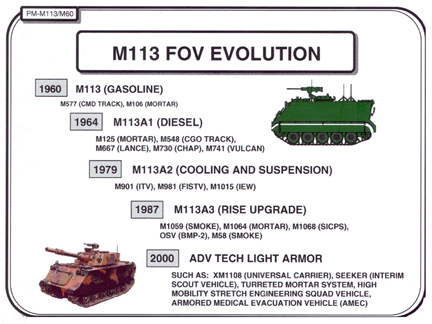


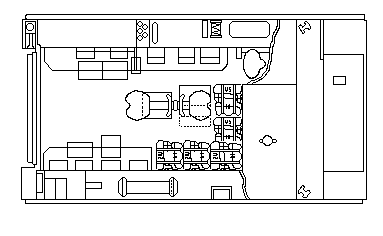
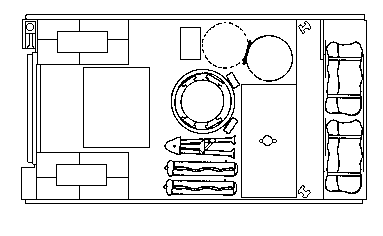
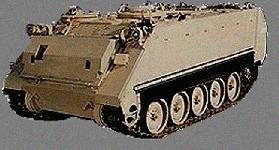
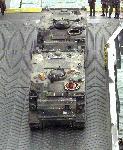
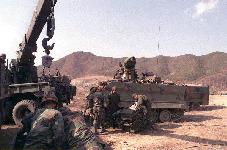
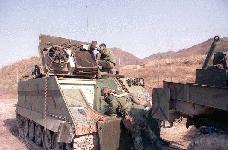

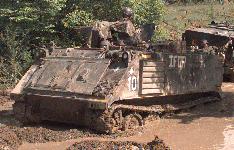

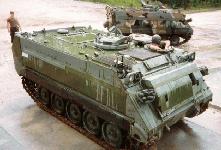
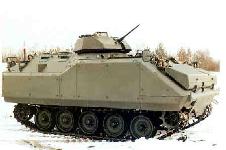
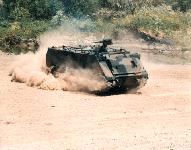

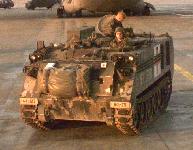
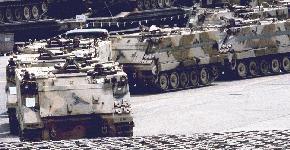
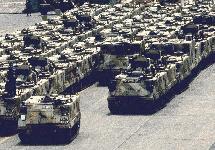
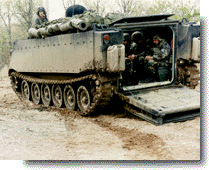 The M113A3+ ESV is the only affordable solution that meets the Combat Engineer Squad requirements to transport an eight man engineer squad and all of their equipment while providing mobility and survivability equal to the maneuver force. The M113A3+ ESV supports the Engineer Squad in the performance of both offensive and defensive obstacle/counter-obstacle operations in support of the maneuver force. The vehicle can be adapted to fulfill other engineer mission objectives including: carrying the Volcano mine dispenser, the pathfinder marking system, and towing the MICLC trailer.
The M113A3+ ESV is the only affordable solution that meets the Combat Engineer Squad requirements to transport an eight man engineer squad and all of their equipment while providing mobility and survivability equal to the maneuver force. The M113A3+ ESV supports the Engineer Squad in the performance of both offensive and defensive obstacle/counter-obstacle operations in support of the maneuver force. The vehicle can be adapted to fulfill other engineer mission objectives including: carrying the Volcano mine dispenser, the pathfinder marking system, and towing the MICLC trailer.
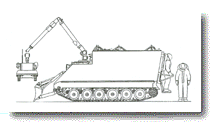 As M113 FOV carriers become excess in the military system a number of conversion options are being considered for asset utilization. United Defense L.P., working with NASA/AMES, has developed the Hazardous Materials Recovery Vehicle (HAZMAT), as one such use for these excess assets. The HAZMAT vehicle utilizes a Stretch M577A3 hull structure incorporating a light dozer blade and a hydraulic manipulator arm. The vehicle provides a versatile chassis for hazardous material recovery operations. The HAZMAT has been designed to retain the air transportability features of the M113 FOV, with C-139 roll-on/roll-off capability. In addition the HAZMAT is being designed to include an over-pressure closed circuit life support system, radiation shielding, a HAZMAT suit docking feature, and a high visibility chemical agent resistant finish. The HAZMAT retains the M113 FOV mobility characteristics to support recovery operations in all terrains.
As M113 FOV carriers become excess in the military system a number of conversion options are being considered for asset utilization. United Defense L.P., working with NASA/AMES, has developed the Hazardous Materials Recovery Vehicle (HAZMAT), as one such use for these excess assets. The HAZMAT vehicle utilizes a Stretch M577A3 hull structure incorporating a light dozer blade and a hydraulic manipulator arm. The vehicle provides a versatile chassis for hazardous material recovery operations. The HAZMAT has been designed to retain the air transportability features of the M113 FOV, with C-139 roll-on/roll-off capability. In addition the HAZMAT is being designed to include an over-pressure closed circuit life support system, radiation shielding, a HAZMAT suit docking feature, and a high visibility chemical agent resistant finish. The HAZMAT retains the M113 FOV mobility characteristics to support recovery operations in all terrains.
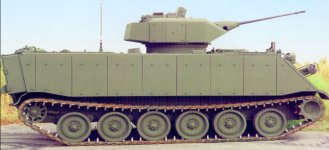 Infantry Fighting Vehicle Light (IFVL) is a light infantry fighting vehicle based on the proven MTVL chassis and featuring a one-man stabilized turret is convertible from existing assets or available as new production. It offers the exceptional automotive performance of the MTVL chassis combined with the substantial firepower of the stabilized 25mm chaingun and 7.62mm machinegun. The vehicle is powered by a 400hp 6V53TIA electronically controlled engine driving through the latest X200-4B cross drive transmission. The IFVL uses many common M113/MTVL components that help insure high reliability, availability, and maintainability, plus a proven design, common maintenance techniques and an established logistics infrastructure. Applique armor provides the flexibility to alter the armor package as the threat level changes or technology advances. The vehicle carries a crew of two or three and up to 10 dismount soldiers. As with all M113 variants,it is roll-on/roll-off transportable on a C130.
Infantry Fighting Vehicle Light (IFVL) is a light infantry fighting vehicle based on the proven MTVL chassis and featuring a one-man stabilized turret is convertible from existing assets or available as new production. It offers the exceptional automotive performance of the MTVL chassis combined with the substantial firepower of the stabilized 25mm chaingun and 7.62mm machinegun. The vehicle is powered by a 400hp 6V53TIA electronically controlled engine driving through the latest X200-4B cross drive transmission. The IFVL uses many common M113/MTVL components that help insure high reliability, availability, and maintainability, plus a proven design, common maintenance techniques and an established logistics infrastructure. Applique armor provides the flexibility to alter the armor package as the threat level changes or technology advances. The vehicle carries a crew of two or three and up to 10 dismount soldiers. As with all M113 variants,it is roll-on/roll-off transportable on a C130.
